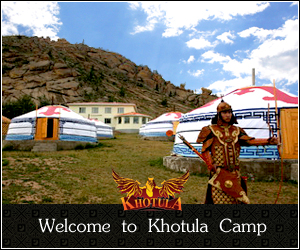Mongol hoomii or throat singing involves producing two simultaneous tones with the human voice. It is a difficult skill requiring special ways of breathing. One tone comes out as a whistle-like sound, the result of locked breath in the chest being forced out through the throat in a specific way, while a lower tone sounds [...]
Mongolian Hat
There were over 100 types of hats, different in shape and purpose – for young and old, men and woman, fashionable and everyday hats. For summer and winter, holiday and ceremonies. Regular hats like “louz” can serve for all occasions. In winter the hat edges can be lowered and protect against wind or cold. On [...]
Traditional Musical Instruments
There are traditional Mongolian string and wind instruments, as well as drums and gongs. Mongolians have made their music through the ages using metal, stone, bamboo, leather and wood. The most popular musical instrument is Morin Khuur (horse fiddle) which is said to represent the movement and sounds of a horse. Traditional Mongolian instruments include: [...]
Traditional Cup Dance
Another popular Western Mongolian dance is performed with cups. You may come across old men and women in the countryside who will tell you with fascination what magnificent dancers performed it in the past when it was very much in vogue. They balanced cups full of water on their heads without spilling a single drop. [...]
Tsagaan sar – Lunar Year

The name means white month and celebrates the passing of winter and beginning of spring. Tsagaan Sar was originally an end of summer festival, but once again it was Genghis Khan who changed things, moving the event to the end of winter in 1216. The Mongolian lunar calendar uses five cycles of twelve years. Each [...]
Folk Dances
Biyelgee Dancing Twisted, distorted “snaky people,” or contortionists, perform the type of classical Mongolian dancing probably most familiar to people outside Mongolia. The “Biyelgee” dance, or dance of the body, is particular to the people of western Mongolia. It is performed to the music of Mongolian national musical instruments, such as the morin khuur (horse [...]
Mongolian practice of burial
-Where to place the dead? How to respect the dead? -What is the reason Buddhist monks do not like to let the catholic priests or christian pastors to visit the family of the dead? People who are very strict Mongolian traditionalists, let the special person called “yaschin” (bone man) to enter first to fix the [...]
Tsam Mask Dancing
It is worth mentioning the traditional religious ritual dance “Tsam ” as an internationally popular Mongolian performance. It is an ancient mixture of theater, dancing, ritual ceremony and of folk tales. Its uniqueness had been highly appreciated in Great Britain, Germany, France, Skandinavian countries and many other parts of the world. The ancient religious mask [...]
Traditional Clothing
Mongolians like to wear nice, richly decorated clothes, compensating for the simple frugal nomadic lifestyle. A harsh climate and uneasy life demand attention to the smallest details of the clothes. It’s amazing how this nation created clothes fitting all seasons and needs well through out and used in many different ways.
Airag or Fermented Horse Milk

Airag, fermented from Mongolian mares, is special because of its nutritious and medical values. Mare’s milk varies in its composition of vitamins (vitamins B1, B2, Br, Pt, C) protein, carbohydrate and fat due to the distinction of the composition and quality of the grass and plant of the areas. Airag is widely used to cure [...]












